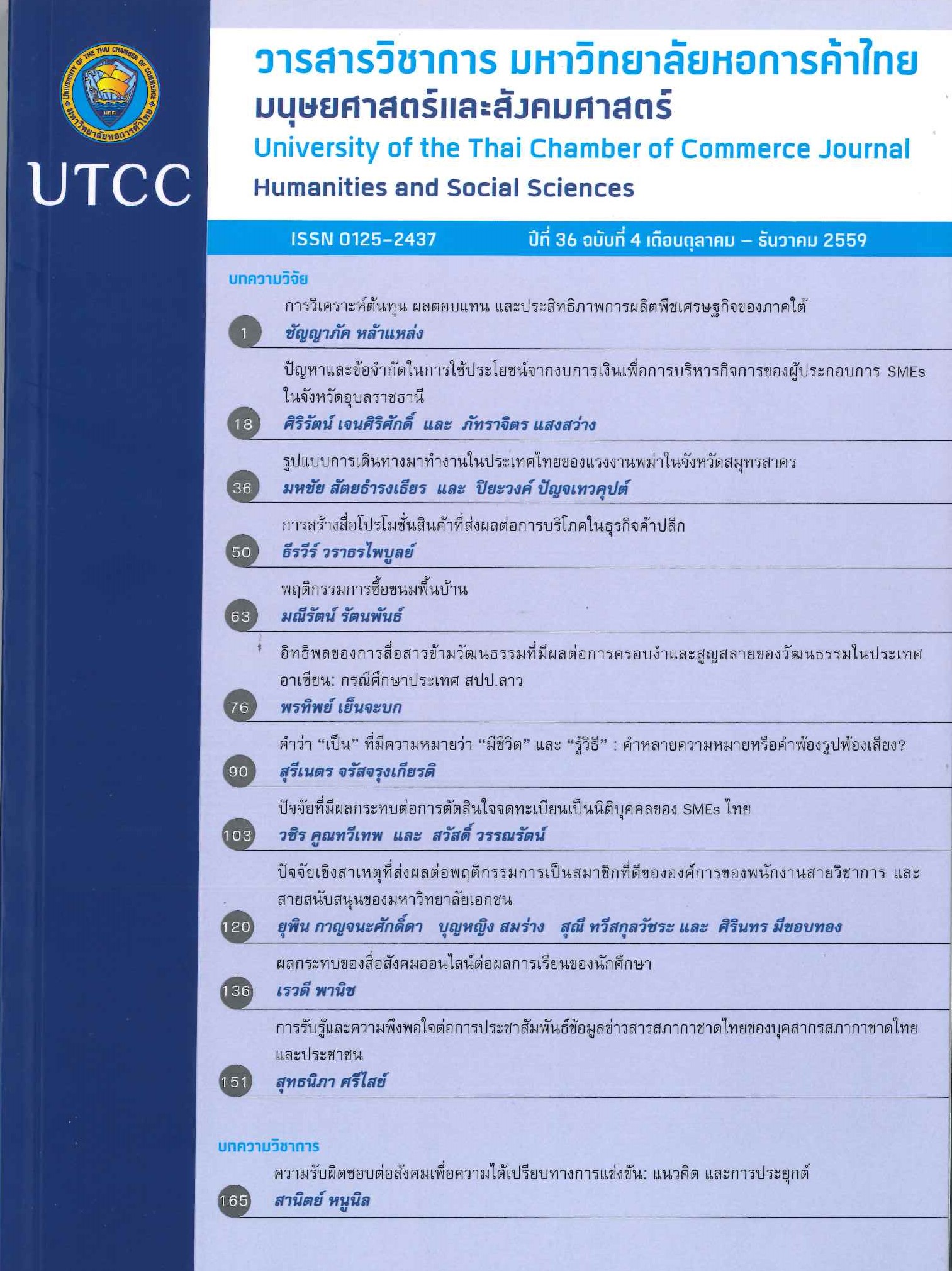The Word /Pen/ Meaning ‘to be alive’ and ‘to know how to do’ in Thai: Polysemy or Homonymy?
Main Article Content
Abstract
This article aimed at studying the word /pen/ meaning ‘to be alive’ and ‘to know how to do’ in Thai. The question addressed here was: should they be considered as polysemy or as homonymy? The collected data was based on written records from the Sukhothai period right up until the present. It was found that the word /pen/ meaning ‘to be alive’ and ‘to know how to do’ should be considered as polysemy. This is because, although these 2 meanings of /pen/ are quite different,
the historical development shows that both meanings are related. That is to say, the word /pen/ meaning ‘to be alive’ is the original word and then develop into the word /pen/ meaning ‘to arise’ and then ‘to know how to do’, respectively. In addition, these changes emerge under 2 processes: metonymic process and metaphorical process.
Article Details
ลิขสิทธิ์ของบทความ
ผลงานที่ได้รับการตีพิมพ์ถือเป็นลิขสิทธิ์ของมหาวิทยาลัยหอการค้าไทย ห้ามมิให้นำเนื้อหา ทัศนะ หรือข้อคิดเห็นใด ๆ ของผลงานไปทำซ้ำ ดัดแปลง หรือเผยแพร่ ไม่ว่าทั้งหมดหรือบางส่วนโดยไม่ได้รับอนุญาตเป็นลายลักษณ์อักษรจากมหาวิทยาลัยหอการค้าไทยก่อน
References
แบรดเลย์, แดนบีช. 2388. ตำราปลูกฝีโคให้กันโรคธระพิศม์ไม่ให้ขึ้นได้. กรุงเทพมหานคร: เอ. บี. ซี. เอฟ. เอ็ม.
Campbell, L. 1999. Historical Linguistics an Introduction. Cambridge: MIT.
Campbell, L., and Mixco, M. 2007. A Glossary of Historical Linguistics. Salt Lake City: University of Utah Press.
Chulalongkorn University. Department of Linguistics. 2013. Thai National Corpus [Online]. Available: https://www.arts.chula.ac.th/~ling/TNCII/ (in Thai).
จุฬาลงกรณ์มหาวิทยาลัย. ภาควิชาภาษาศาสตร์. 2556. โครงการคลังข้อมูลภาษาไทยแห่งชาติ [ออนไลน์]. เข้าถึงจาก https://www.arts.chula.ac.th/~ling/TNCII/
Collection of Ayutthaya Archival Documents Volume 1. 1967. Bangkok: Prime Minister's Office. (in Thai).
ประชุมจดหมายเหตุสมัยอยุธยา ภาค 1. 2510. กรุงเทพมหานคร: สำนักนายกรัฐมนตรี.
Enfield, N. J. 2008. “Verbs and Multi-Verb Construction in Lao”. In A. V. Diller, J. A. Edmondson, and Y. Luo (Eds.), The Tai-Kadai languages, pp. 83-183. London: Routledge.
Hopper, P., and Traugott, E. 2003. Grammaticalization. Cambridge: Cambridge University Press.
Koohacharoen, Tuangrat. 2014. “Contents and Language of Songs about Thailand’s 2011 Floods: A Reflection of Thai Society.” University of the Thai Chamber of Commerce Journal 34, 4: 75-91. (In Thai).
ตวงรัตน์ คูหเจริญ. 2557. “เนื้อหาและภาษาในเพลงเกี่ยวกับน้ำท่วมประเทศไทย พ.ศ. 2554: ภาพสะท้อนสังคมไทย.” วารสารวิชาการ มหาวิทยาลัยหอการค้าไทย 34, 4: 75-91.
Limlertsathien, Paramaporn. 2014. “The Dynamic of Idioms and Thai Proverbs in the Popular Culture Period.” University of the Thai Chamber of Commerce Journal 34, 4: 201-218. (In Thai).
ปรมาภรณ์ ลิมป์เลิศเสถียร. 2557. “พลวัตของสำนวน สุภาษิตไทยในยุควัฒนธรรมสมัยนิยม.” วารสารวิชาการ มหาวิทยาลัยหอการค้าไทย 34, 4: 201-218.
Naritsara Nuwattiwong, H.R.H Prince. 1963. The Memoir of Journey to Phitsanulok. Pranakhorn: Prajan Printing house. (in Thai).
นริศรานุวัดติวงศ์, สมเด็จเจ้าฟ้ากรมพระยา. 2506. จดหมายระยะทางไปพิษณุโลก. พระนคร: โรงพิมพ์พระจันทร์.
National Archive of King Rama II (C.S. 1173). 1971. Bangkok: Kurusapa Printing House. (in Thai).
จดหมายเหตุสมัยรัชกาลที่ 2 (จ.ศ. 1173). 2514. กรุงเทพมหานคร: โรงพิมพ์คุรุสภา.
Pallegoix, D.J. 1850. Grammatica Linguae Thai. Bangkok: n.p.
Panupong, Vichin. 1995. The Structure of Thai: Grammatical System. Bangkok: Ramkhamhaeng University Press. (in Thai).
วิจินตน์ ภาณุพงศ์. 2538. โครงสร้างภาษาไทย: ระบบไวยากรณ์. กรุงเทพมหานคร: โรงพิมพ์มหาวิทยาลัยรามคำแหง.
Poon Pismai Diskul, M.C. 2003. My Experience: History of the 1932 Revolution. Bangkok: Matichon. (in Thai).
พูนพิศมัย ดิศกุล, หม่อมเจ้าหญิง. 2546. สิ่งที่ข้าพเจ้าพบเห็น ประวัติศาสตร์เปลี่ยนแปลงการปกครอง 2475. กรุงเทพมหานคร: มติชน.
Praratchapuccha (Royal Inquiries on Buddhist Problems) of Rattanakosin from the Reigns of King Rama I to King Rama IV, Volume 1 and 2. 1970. Bangkok: Kurusapa Printing House. (in Thai).
พระราชปุจฉาในชั้นกรุงรัตนโกสินทร์ ตั้งแต่รัชกาลที่ 1 ถึง รัชกาลที่ 5 เล่ม1 และ 2. 2513. กรุงเทพมหานคร: โรงพิมพ์คุรุสภา.
Siburapha. 2005. Behind the Painting. Bangkok: Dokya Publishing House. (in Thai).
ศรีบูรพา. 2548. ข้างหลังภาพ. กรุงเทพมหานคร: ดอกหญ้า.
Thailand. Fine Arts Department. 1962. Letters of Luang Udomsombat. Bangkok: Fine Arts Department. (in Thai).
กรมศิลปากร. 2505. จดหมายหลวงอุดมสมบัติ. กรุงเทพมหานคร: กรมศิลปากร.
Thailand. Fine Arts Department. 1983. Sukhothai Inscriptions. Bangkok: Fine Arts Department. (in Thai).
กรมศิลปากร. 2526. จารึกสมัยสุโขทัย. กรุงเทพมหานคร: กรมศิลปากร.
Thailand. Royal Institute of Thailand. 2013. Thai Dictionary: The Royal Institute’s edition 2011. Bangkok: Royal Institute of Thailand. (in Thai).
ราชบัณฑิตยสถาน. 2556. พจนานุกรมฉบับราชบัณฑิตยสถาน พ.ศ. 2554. กรุงเทพมหานคร: ราชบัณฑิตยสถาน.
Vongvipanon, Peansiri. 2002. “Unit 13: Meaning”. In Thai 3 (Unit 7-15), The Tai-Kadai languages, pp. 287-368. Nonthaburi: Sukhothai Thammathirat University Press. (in Thai).
เพียรศิริ วงศ์วิภานนท์. 2545. “หน่วยที่ 13: ความหมาย”. ใน เอกสารการสอนชุดวิชา ภาษาไทย 3 หน่วยที่ 7-15, หน้า 287-368. นนทบุรี : มหาวิทยาลัยสุโขทัยธรรมาธิราช.

